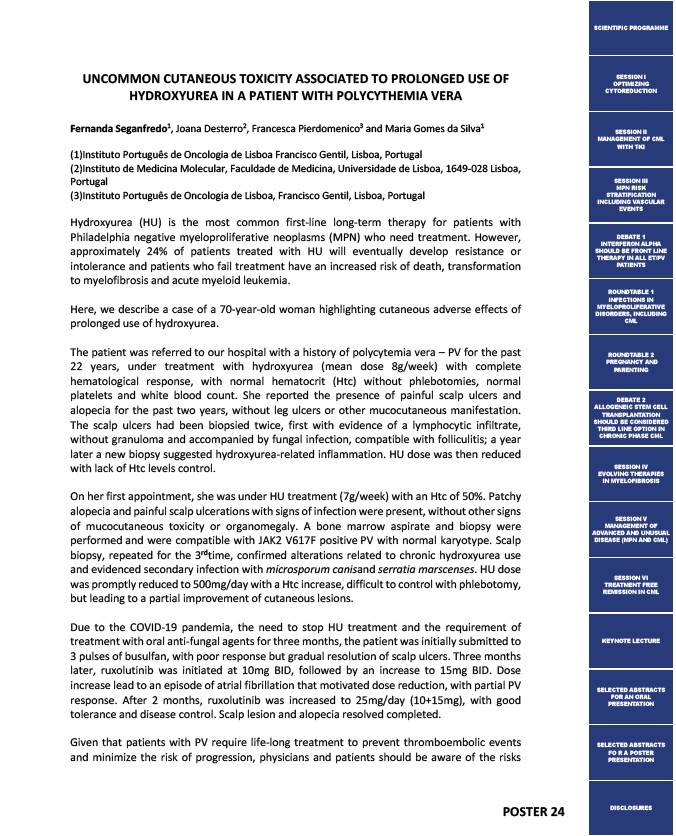
UNCOMMON CUTANEOUS TOXICITY ASSOCIATED TO PROLONGED USE OF
POSTER 24
HYDROXYUREA IN A PATIENT WITH POLYCYTHEMIA VERA
Fernanda Seganfredo1, Joana Desterro2, Francesca Pierdomenico3 and Maria Gomes da Silva1
(1)Instituto Português de Oncologia de Lisboa Francisco Gentil, Lisboa, Portugal
(2)Instituto de Medicina Molecular, Faculdade de Medicina, Universidade de Lisboa, 1649-028 Lisboa,
Portugal
(3)Instituto Português de Oncologia de Lisboa, Francisco Gentil, Lisboa, Portugal
Hydroxyurea (HU) is the most common first-line long-term therapy for patients with
Philadelphia negative myeloproliferative neoplasms (MPN) who need treatment. However,
approximately 24% of patients treated with HU will eventually develop resistance or
intolerance and patients who fail treatment have an increased risk of death, transformation
to myelofibrosis and acute myeloid leukemia.
Here, we describe a case of a 70-year-old woman highlighting cutaneous adverse effects of
prolonged use of hydroxyurea.
The patient was referred to our hospital with a history of polycytemia vera – PV for the past
22 years, under treatment with hydroxyurea (mean dose 8g/week) with complete
hematological response, with normal hematocrit (Htc) without phlebotomies, normal
platelets and white blood count. She reported the presence of painful scalp ulcers and
alopecia for the past two years, without leg ulcers or other mucocutaneous manifestation.
The scalp ulcers had been biopsied twice, first with evidence of a lymphocytic infiltrate,
without granuloma and accompanied by fungal infection, compatible with folliculitis; a year
later a new biopsy suggested hydroxyurea-related inflammation. HU dose was then reduced
with lack of Htc levels control.
On her first appointment, she was under HU treatment (7g/week) with an Htc of 50%. Patchy
alopecia and painful scalp ulcerations with signs of infection were present, without other signs
of mucocutaneous toxicity or organomegaly. A bone marrow aspirate and biopsy were
performed and were compatible with JAK2 V617F positive PV with normal karyotype. Scalp
biopsy, repeated for the 3rdtime, confirmed alterations related to chronic hydroxyurea use
and evidenced secondary infection with microsporum canisand serratia marscenses. HU dose
was promptly reduced to 500mg/day with a Htc increase, difficult to control with phlebotomy,
but leading to a partial improvement of cutaneous lesions.
Due to the COVID-19 pandemia, the need to stop HU treatment and the requirement of
treatment with oral anti-fungal agents for three months, the patient was initially submitted to
3 pulses of busulfan, with poor response but gradual resolution of scalp ulcers. Three months
later, ruxolutinib was initiated at 10mg BID, followed by an increase to 15mg BID. Dose
increase lead to an episode of atrial fibrillation that motivated dose reduction, with partial PV
response. After 2 months, ruxolutinib was increased to 25mg/day (10+15mg), with good
tolerance and disease control. Scalp lesion and alopecia resolved completed.
Given that patients with PV require life-long treatment to prevent thromboembolic events
and minimize the risk of progression, physicians and patients should be aware of the risks
SCIENTIFIC PROGRAMME
SESSION I
OPTIMIZING
CYTOREDUCTION
SESSION II
MANAGEMENT OF CML
WITH TKI
SESSION III
MPN RISK
STRATIFICATION
INCLUDING VASCULAR
EVENTS
DEBATE 1
INTERFERON ALPHA
SHOULD BE FRONT LINE
THERAPY IN ALL ET/PV
PATIENTS
ROUNDTABLE 1
INFECTIONS IN
MYELOPROLIFERATIVE
DISORDERS, INCLUDING
CML
ROUNDTABLE 2
PREGNANCY AND
PARENTING
DEBATE 2
ALLOGENEIC STEM CELL
TRANSPLANTATION
SHOULD BE CONSIDERED
THIRD LINE OPTION IN
CHRONIC PHASE CML
SESSION IV
EVOLVING THERAPIES
IN MYELOFIBROSIS
SESSION V
MANAGEMENT OF
ADVANCED AND UNUSUAL
DISEASE (MPN AND CML)
SESSION VI
TREATMENT FREE
REMISSION IN CML
KEYNOTE LECTURE
SELECTED ABSTRACTS
FOR AN ORAL
PRESENTATION
SELECTED ABSTRACTS
FO R A POSTER
PRESENTATION
DISCLOSURES